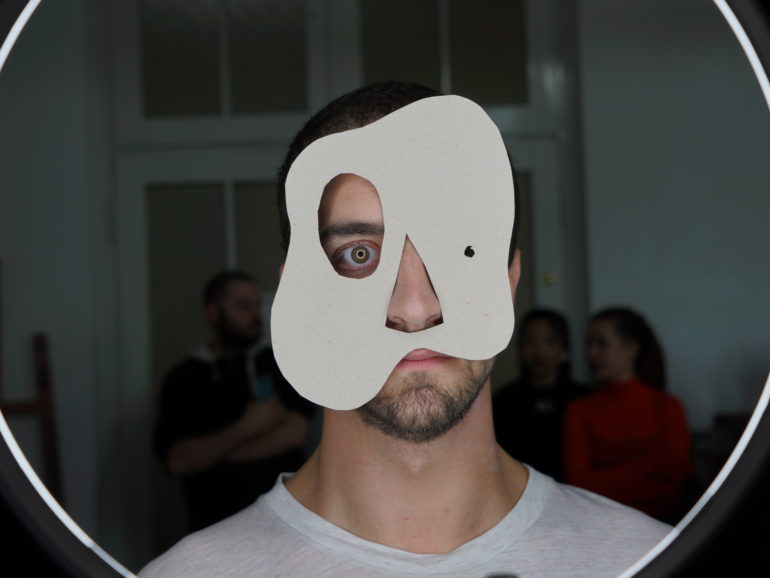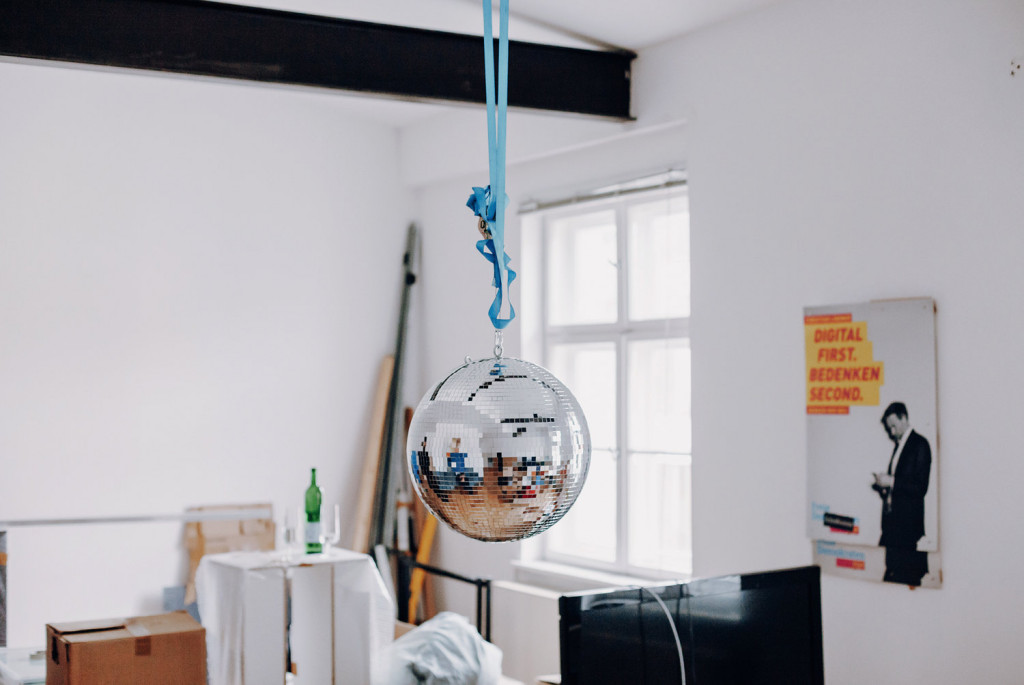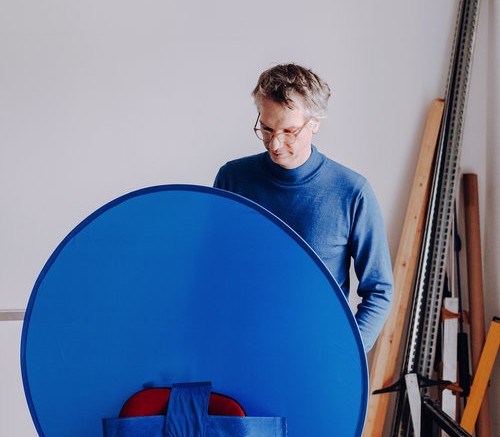
Face the Face
Ein Gespräch mit Prof. Aram Bartholl über Maskierung im öffentlichen Raum.
Autor, Björn Lange, 23-04-2020
https://magazine.fork.de/masquerade/face-the-face
Dieses Gespräch kam eher durch Zufall zustande: Nachdem das Thema für die fünfte Ausgabe des Unstable Mag feststand, hörte ich im Radio einen Beitrag über ein Seminar an der Hochschule für Angewandte Wissenschaften Hamburg (HAW Hamburg) – Face the Face. Bei dem Projekt unter der Leitung von Prof. Aram Bartholl stand unter anderem Gesichtserkennung im Fokus, sowie die analogen Möglichkeiten, sich digital unkenntlich zu machen. Spontan nahm ich im Februar Kontakt auf, und nun, Mitte April, gelang uns endlich das persönliche Treffen, face to face, per Hangout…
Hallo Aram, schön, dass das unter den aktuellen Umständen doch irgendwie mit unserem Gespräch geklappt hat! Ich will gar nicht lange drumrum reden – Fork und das Unstable Mag hatte ich dir ja schon kurz erläutert. Lass uns also direkt einsteigen… Warum überhaupt dieser Ansatz, Gesichtserkennungssoftware umgehen zu wollen? Müssen wir uns verstecken heutzutage?
Gute Frage. Es gibt da unterschiedlichste Meinungen zu. Gerade heute, in Zeiten von Covid-19-App, Tracking, Tracing, Handy-Bewegungsprofilen und so weiter ist das Thema Anonymität für uns als Gesellschaft schon sehr wichtig. Theoretisch wissen wir auch – also viele jedenfalls –, dass unsere Privatsphäre durchaus gefährdet ist, durch große digitale Firmen wie Facebook, Google, Microsoft. Unternehmen, die ohne Ende Daten sammeln. Bloß spüren wir das natürlich nicht. Das eigene Gesicht aber, das ist etwas, das wir alle verstehen: Häh, da ist ein Foto von mir!? Ich glaube, das Gesicht und die Erkennung des Gesichtes und die Diskussion darum ist ein wertvoller Einstieg, um über Privatsphäre zu reden. Ah, ja, es gibt da dieses Clear View, und die haben zwei Milliarden, drei Milliarden Bilder gesammelt von allen Menschen auf der Welt, und jeder kann darauf zugreifen… Äh, das geht doch nicht! Das verstößt doch gegen diese Datenschutzgrundverordnung. Und das verstehen auch Leute, die normalerweise keinen technischen Zugang haben. Und dann kann man auch über Daten im Browser reden und über Cookies und über Tracking-Pixel. Also über Dinge, die viel abstrakter sind und die man nur schwer vermitteln kann.
Lustigerweise haben Leute etwas wie das Gesicht aber gar nicht so sehr auf dem Schirm, oder? Wenn ich da an mein persönliches Umfeld denke – da ist vielen plausibel, dass wenn sie online ihre Daten eingeben, händisch, also Adresse, Geburtsdatum, das übliche, dass sie da bewusster reflektieren, dass Sie gerade Daten Preis geben, als sie es mit ihrem eigenen Gesicht verbinden.
Ja, ich glaube, zu einem gewissen Punkt haben wir uns daran gewöhnt, irgendwie, dass diese Datenfreigabe dazugehört. Ich weiß es nicht genau. Gleichzeitig kann man nun – und das ist so’n bisschen eine andere Diskussion – bei diesem Masken Tragen, den medizinischen Masken, meine ich, eine Form von… ja, Vorbehalt gegenüber der Anonymität beobachten. Hier in Deutschland, da wollen die Leute das nicht so richtig, oder? Am Anfang ist man ganz komisch angeguckt worden im Supermarkt. Jetzt wird es dann doch wahrscheinlich Pflicht, demnächst.
Interessant, dass du das ansprichst. Das wäre sonst eine meiner späteren Fragen gewesen. Mein Eindruck, im Moment, wenn ich einkaufen gehe, ist schon, dass ich mich komisch fühle, weil ich noch keine Maske trage. Also, bei uns hier in Hamburg-Eimsbüttel. Die Quote an getragenen Masken im Supermarkt ist irre hoch, und da hab ich mich schon gefragt, ob sowas wie die aktuelle gesundheitliche Krise als eine Art Türöffner für den Mainstream wirken könnte. Ob wir uns jetzt gerade alle daran gewöhnen, dass Maske eine Option ist?
Ja, genau. Das ist auch eine der interessanten Fragestellungen – ob sich durch diese Corona-Krise entsprechende Dinge, Wahrnehmungen, verändern. Genauso, wie sich derzeit auch vieles in der Kommunikation verändert und ins Digitale verschiebt. Womit wir wieder zu der Gesichtserkennungsdiskussion kommen: Vielleicht ist es demnächst so, dass wir wissen, wir sind online irgendwie “nackt”, aber draußen dann immer voll verschleiert. Der ehemals öffentliche Raum, wird das jetzt ein voll anonymer Raum? Dann gehen wir nach Hause und sind auf Chatroulette wieder nackt, sozusagen. Wird das so eine komische Verkehrung? Und was ich mich auch gefragt habe: Es gibt ja vieles im Bereich der Snapchat- und Instagram-Filter; das ist ja eine Kultur, die jetzt schon eine Weile läuft und auch interessante Ausprägungen besitzt – nicht nur Hundeschnauze, Katzennase oder so. Gerade im asiatischen Raum findet man Video-Streamer und YouTuber, die immer nur mit Avatar auftreten. Bei denen man gar nicht weiß, wie die aussehen, weil die komplett eine Maske auf haben.
Eine digitale oder eine echte?
Eine digitale – Personen, die immer irgendwie was im Gesicht haben oder auch komplett digital verfremdet sind, so dass du gar nicht weißt, wer das ist. Das sind Beispiele für verschiedene Richtungen der Maskierungen. Die gleichzeitig, nebeneinander in unterschiedlichen Kontexten stattfinden, aber sich schon auch gegenseitig beeinflussen. Und dadurch interessant zu beobachten sind.
Wie bist du denn eigentlich überhaupt an dieses Thema herangekommen? Eher über die Gesichtsfilter, also den digitalen Aspekt, oder über das tatsächliche Maskieren und das Ausschalten von Gesichtserkennung?
Face the Face hieß ja der Kurs an der Hochschule. Aber – und da liegt der eigentliche Anfang – Face the Face war auch der Name einer Ausstellung, die ich mit Annika Meier zusammen kuratiert habe, eine so genannte Speedshow. Die lief letztes Jahr im Herbst hier in Berlin in einem Internet-Café, und da lag der Fokus bereits auf dem Thema Facefilter. Das war inhaltlich ein Hauptaugenmerk dieser Ausstellung, fand aber gleichzeitig auch im Kontext von Netzkunst statt – die für sich genommen viel älter ist, die sich aber auch immer schon um Fragen der Identität und des Gesichtes im Zusammenspiel mit Kamera und Computer gedreht hat. Und über Aspekte wie Social Media, Net Art, Facefilter entstand dann dieser Kurs an der HAW, der ein bisschen breiter angelegt war. Da hing für mich automatisch der Bereich Gesichtserkennung mit dran. Privacy und Anonymitätsfragen im Internet, das sind genau die Themen, die sehr klassisch bei mir mitlaufen, schon seit Jahren.
Warum treibt dich Anonymität so sehr um?
Ähnlich meiner Antwort auf deine Eingangsfrage halte ich die Privatsphäre und die Anonymität, die wir in unserer Gesellschaft besitzen, für ein sehr hohes Gut. Und für eine wichtige Grundlage der Demokratie, in der wir leben. Wenn die den Bach runtergeht und wir in eine totale Überwachung geraten, dann haben wir ein riesiges Problem. Irgendwie habe ich schon immer auf dieses Thema geschaut und mich dafür interessiert. Was ist die neueste Entwicklung? Was kann man damit machen? Und wenn man das ein bisschen versteht oder sich damit auskennt, dann macht das nicht nur Spaß, sondern ermöglicht einem, etwas zu tun, das auch sozial tief eingreift. Gerade in einer Atmosphäre, in der so eine Nothing-to-hide-Haltung herrscht: Joa, ich mach’ das einfach… weil ist doch egal.
Genau, dieses ich habe doch nichts zu verbergen, was soll’s mich also kümmern?!
Ja, und an dem Punkt kann man sagen: Dann zieh’ dich doch aus, wenn du nichts zu verbergen hast, oder Gib mir mal alle deine Logins für deine Accounts! – Ja, nee, so jetzt aber auch wieder nich’. Und das Bewusstsein dafür, das ist schon fundamental wichtig. Ich glaube auch, dass in der Politik diese Zusammenhänge, dieses Für und Wider, einigen Leuten klar ist. Aber der Druck wird halt immer größer, auch und gerade bei so etwas wie der Covid-App. Der Druck aus der Industrie, aber auch aus der Politik. Für eine einseitige Form der Transparenz. Der vermeintlichen Sicherheit. Da werden bestimmte Freiheitsrechte hier und da sehr stark eingeschränkt. Und einerseits weißt du, okay, das muss jetzt so. Andererseits kannst du aber auch gar nicht mehr demonstrieren, zum Beispiel.
Inwiefern sind dann die Masken, die in dem Seminar entstanden sind, innerhalb des Projekts Face the Face, inwieweit sind die denn schon Lösungen? Oder stellen sie vielmehr einen Fingerzeig auf das Thema dar?
Ich würde sagen beides. Das Interessante daran: An der Hochschule gibt’s ja verschiedene Design-Fachrichtungen, die dort studiert werden. Und du triffst eben auch auf Leute aus der Mode, die einen ganz anderen Umgang mit Material pflegen und wie man beispielsweise etwas trägt. Ursprünglich bezieht sich die Aufgabenstellung des Seminars auf ein Projekt namens CVdazzle von Adam Harvey, das circa acht Jahre alt ist. Damals lag der Ansatz darin, sich so zu schminken und eine Frisur zu tragen, dass Kamera und Software das menschliche Gesicht nicht mehr als solches erkennen konnten. Wir haben an der Hochschule über Themen wie Privatsphäre gearbeitet, und eigentlich war das mit diesen Masken nur so ein kurzes Projekt, im Grunde eine Fingerübung. Allerdings mit der spannenden Prämisse, etwas zu kreieren, das man im Gesicht trägt, aber leicht entfernen kann. Schminke must du abschminken – das nimmt dir die Flexibilität. Aber so etwas wie eine Brille, die ich im Gesicht trage, die mich irgendwie verfremdet, die ich aber spontan wieder absetzen kann. Wie wäre das? Wie sähe das aus? Ein bisschen haben wir diese Situation ja jetzt mit den medizinischen Masken, die auf einmal von allen getragen werden. Jedenfalls sind in dem Seminar einige Sachen bei rausgekommen – manche von den Masken sind auch unsinnig oder einfach lustig. Dennoch ist das Szenario, das mit den Exponaten verknüpft ist, gleichbleibend interessant: zum einen, weil du die Maske gegen die Software in der Kamera testen musst. Und zum anderen, weil du sie gleichzeitig auch sozial testest. Wie sehe ich damit aus? Wie reagieren denn die Leute damit auf mich? Will jemand mit mir reden, wenn ich so etwas trage? Und das sind im Kern ganz wichtige Fragen. Ich fände es schon interessant, etwas in dem Bereich zu entwickeln, das meine digitale Anonymität wahrt und trotzdem socially acceptable ist. Das war so ein bisschen die Idee dahinter, und da hängen dann verschiedene Diskussionen dran. Dass wir dieses Gespräch gerade führen, das ist eigentlich das, worum es geht – als Gesellschaft die Frage der Privatsphäre zu sehen und sich darüber auszutauschen.
Wenn ich die Funktionsweise von Wearable CVdazzles richtig verstanden habe, dann helfen uns die medizinischen Gesichtsmasken unter dem Aspekt eigentlich nicht weiter, oder? Weil eigentlich, ja, was genau unkenntlich sein muss – die Augenpartie?
Ja, aber ich glaube, die medizinische Maske plus eine Sonnenbrille… also die deutsche Gesichtserkennung findet da nichts mehr. Ich finde vor allem die selbst genähten Masken und dieses ganze Bunte, was da jetzt kommt, gegenüber den chirurgisch anmutenden Masken… das ist doch total gut. Da wird so eine DIY-Welle losgetreten, und zu Hause sitzen ganz viele und nähen noch die Form oder die Form. Meine Mutter hat mir auch schon welche geschickt. Ich halte das wirklich für eine spannende Sache; mit der Kultur, die da drumherum entsteht. Da stecken durchaus auch politische Themen mit drin. Und nehmen wir mal an, dass wir uns noch auf Jahre hinaus gegen Erreger schützen müssen oder unsere Mitmenschen vor einer Ansteckung durch uns, so tut sich doch ein nicht unspannender Zwischenraum auf, in dem wir uns bewegen werden. Da können Gewohnheiten aufbrechen. Und vielleicht sogar soziale beziehungsweise zwischenmenschliche Komponenten neu ins Spiel kommen.
In dem Kurs – gab es da sozusagen eine Lieblingsmaske bei dir? Eine Maske, die du für besonders gelungen hältst?
Es gab ein paar. Manche, die zum Beispiel in der Bewegung sehr gut funktioniert haben. Mit Lametta oder Ketten vor dem Gesicht. Bei denen hatte die einfache Erkennungs-Software schon starke Probleme, einfach nur wegen der Bewegung. Ich fand aber eine bemerkenswert, die mit wenig Mitteln sehr gut abgeschnitten hat – mit den weißen Kreuzen rechts und links. Die hat nicht nur optisch sehr gut funktioniert, sondern konnte auch sozial überzeugen: Mit dem Träger war für mich als Gegenüber tatsächlich ein Gespräch möglich. Die Maske besaß so design-technische Aspekte, die genial einfach in der Umsetzung waren. Dass jemand ein alltägliches Objekt nimmt, einen Kleiderbügel aus Draht, und mit Klebeband kombiniert Erkennungs-Software austrickst… Für mich gerade auch ästhetisch eine spannende Lösung. Gut gefiel mir zudem die Variante mit dem Netz und den Kugeln vor dem Gesicht. Das wirkt schon sehr modisch und kann so in Hamburg oder in Berlin problemlos auf der Straße getragen werden. Da würde dich keiner komisch angucken, deswegen.
Ja, das sieht fast so aus, als ob es einen kulturellen Background besäße.
Genau, da finden sich verschiedene Anspielungen drin wieder, die einem irgendwie vertraut vorkommen. Auch die Fechtmaske ist ein gutes Beispiel. Die wirkt natürlich deutlich abweisender; dafür verzerrt sie aber auch das Gesicht dahinter ausgesprochen wirksam. Doch, da sind etliche interessante Richtungen eingeschlagen worden.
Danke schön, Aram, für die Einblicke in das Projekt Face the Face und deine Arbeit. Wie’s nach unserem Gespräch weitergeht: Momentan planen wir, in ein paar Tagen mit der fünften Ausgabe – “Maskerade” – live zu gehen. Für dich vielleicht auch nicht uninteressant: Eine Kollegin von mir wird sich mit einer ehemaligen Fork-Mitarbeiterin austauschen, die inzwischen im Bereich Fashion auf Instagram als Model und Fotografin aktiv ist. In dem Gespräch wird es um Aspekte wie Schminken und die verschiedenen Rollen gehen, in die sie vor der Kamera schlüpft.
Ich bin gespannt. Das heute hat Spaß gemacht – jetzt haben wir wahrscheinlich eine halbe Stunde miteinander gesprochen, deutlich länger als in meinen letzten Radio-Interviews üblich. Schön, wenn man mehr als fünf Minuten hat, um sich auf ein Thema einzulassen.
Autor
Björn Lange
23-04-2020



